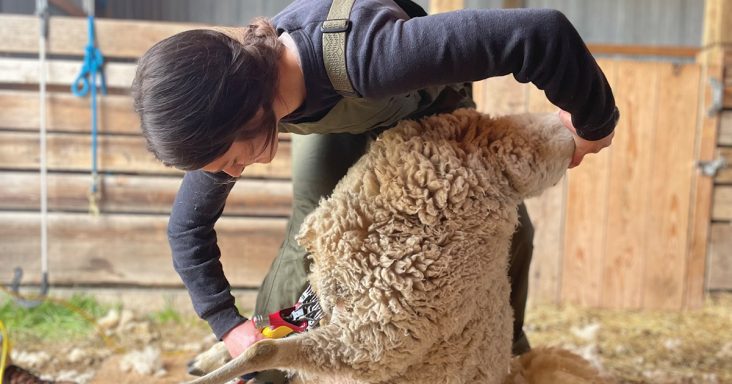Reshoring garment industry won’t be quick, easy task
by July 8, 2025 3:50 pm 808 views

Reshoring the garment industry won’t happen overnight, but area industry professionals expect its revitalization to start with the support of local sewists, workforce development and a consumer behavior shift.
According to the U.S. Bureau of Labor Statistics, the number of apparel manufacturing jobs in May 2025 was estimated at 82,600, down 91% from 908,500 in May 1990. BLS job data dates back to 1990.
Abby Hollis is director of product and sustainability for Bentonville-based outdoor apparel company LIVSN Designs. She’s also a shearer for Heft Shearing and co-founder of Ozark Fibershed, a regional affiliate of a nationwide nonprofit working to revitalize the domestic textile industry.
“We’re starting from the very beginning,” Hollis said. “We work with connecting sheep farmers with spinners, and we’ve done some panels as far as what’s missing from our regional textile system and … dreaming of what the future could look like. We recently put on a sheep shearing school in collaboration with the university … It’s going back even further than some of the stuff that’s being talked about right now with domestic manufacturing and really starting at the fiber level …
“My personal perspective on all of it … comes from that foundation. As a company, we see a lot of value in starting to develop these systems. This started with our repair program … and that was really our first step into working with local sewists … It makes more sense to hire people locally to repair things because they’re already here as opposed to sending them off to be repaired.”
Since then, LIVSN has sought to build on these relationships to ensure sewists have consistent work from the company and collaborate with them to develop sustainable businesses, Hollis said.
‘TAKE SOME SACRIFICE’
LIVSN recently collaborated with sewist Brandy Lee, founder of Fayetteville-based Big Sister Studio, to create a small batch of aprons. Lee has been a professional sewist for 17 years and said making the aprons exemplified how sewists can contribute to reshoring the garment industry.
“While I did most of the sewing myself, I did have a team that helped me,” she said. “It is not the most glamorous work in the world to … do the same thing 50 times in a row, but making that sacrifice to … do this uncomfortable, hard work is honestly I think what it’s going to take.”
She said she knows a lot of sewists only want to design clothes and be artistic, but to reshore the industry, “it’s going to take some sacrifice and … some patience on behalf of our brands because we just don’t have that skilled labor yet. It’s going to take time to train people to be good at this work, but it absolutely can happen. There’s absolutely the talent here.”
Hollis said projects like this allow the company to identify existing systems that are already in place. “What does it look like for us to make something locally?” she said. “What are the challenges there? What works? What doesn’t work? And that’s sort of where we started, so we’re excited to have done that, see how it goes and build on that.”
Hollis said the timeline to reshore the industry is uncertain. However, she expects it to be “a long process, and I believe it should be an iterative process and not forced.”
Excluding the equipment and infrastructure, there’s a lack of skills and workforce development to reshore the industry overnight, she said.
“I think because we as a culture have devalued that skill for so long, we’ve devalued sewing and we’ve sort of prioritized this knowledge-based economy,” she said. “We have this bias to think that those manufacturing jobs in sewing are easy and can be learned quickly. That isn’t the case … The sewists we work with are highly skilled and have been doing it for years. There’s not a way to say a month from now we’re going to open a factory, teach all these people how to sew and they’re going to be ready to go.”
She said LIVSN is supporting local sewists and providing them with enough business to allow them to hire new employees and apprentices, and “facilitate that workforce development in sort of an organic way as their businesses grow.”
CONSUMER CULTURE CHANGE
Asked whether fully reshoring the industry would be economically feasible, Hollis said this “would require a huge shift in our consumer culture …
“We have this sort of throw-away culture that says … clothes are frivolous, we need to buy a whole bunch of them and always be on trend … There are ways to have fun with your clothes and express yourself but consume less and keep things in circulation longer. I think that the consumer culture has to change in order for the production culture to be able to change … to be able to support that type of capacity limitation as well as the price that would come along with domestic manufacturing.”
LIVSN also plans to work with Lee on sampling and development for new products. Lee said she wants to help make the design process easier. Hollis said the plan would still be to send the samples to its supplier partners in Vietnam for production.
“But it’s sort of starting to build in that relationship where it makes sense to, and then of course things like the run of aprons and starting to build up those production runs,” Hollis said. “As a consumer, it’s … similar … A lot of these sewists will do repairs or hemming … so that is a good way to participate … There’s also folks like Brandy who makes clothes from fabric, is a designer and makes her own stuff. So, supporting those businesses … and also brands who are working with local folks.”
Hollis and Lee met because they “ran in the same circles. I’m a maker myself. I don’t sew at the level Brandy does, but I’m a spinner and a weaver. I dabble in sewing … We just met through our shared love of craft.”
Big Sister Studio started handling LIVSN’s repair program after Springdale nonprofit Interform closed earlier this year. Area partners including Interform, Lee and Tabitha Buckner have been repairing LIVSN products since 2021.
“I enjoy those repairs because that tells me that the customer loves this garment enough to wear it down,” Lee said. For holes, she patches them like one would patch a bike tire but on the underside of the garment. The stitch mimics the garment’s weave to create a new fabric layer.
FLEX CANVAS APRONS
In the recent collaboration, Big Sister Studio produced 50 Flex Canvas aprons for LIVSN. The small production run followed an even smaller run for Campfire Ranch, a Colorado-based outdoor hospitality brand working with landowner Blue Crane to reopen the Inn at Bella Vista this fall as seven-room lodge Campfire Ranch Little Sugar.
LIVSN, Lee and Buckner collaborated to create the original five aprons last summer. The success of those aprons led to the introduction of new Flex Canvas aprons this year.
Hollis said the new aprons are slightly different in terms of pocket layout, with a slit added, allowing people to ride a bicycle while wearing them. Listed on the company’s website for $169, they’re also sold at its store at 3803 N.W. Wishing Springs Road in Bentonville.
Lee said each apron takes about two hours to make, features a patchwork design, and the slit or vent at the center bottom allows for easy movement. Typical aprons restrict movement because of their solid, one-piece design.
Lee started Big Sister Studio in 2017 in Austin, Texas, before relocating to Fayetteville the following year. She said her short-term goal is to offer sewing services and do something more artistic later in the year. Big Sister Studio has one intern and two part-time staff.
